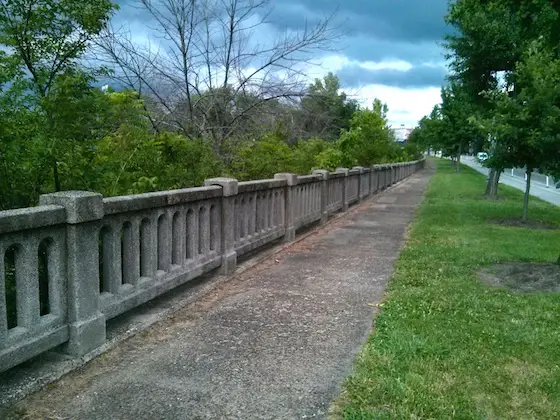
The center of the photo looks like salt damage to concrete. The top surface of the concrete scales off and reveals the rough rock and sand below. Blame the concrete contractor, not the salt. Read below how to prevent salt damage. Copyright 2018 Tim Carter
Salt Damage to Concrete - Don't Blame the Salt
Salt is often blamed for damaging concrete. The top surface of concrete sidewalks, driveways and patios may spall or scale off after you broadcast salt on it to melt snow and ice.
The salt is indirectly responsible only because it helps promote more freeze and thaw cycles within the top surface of the concrete. The first thing to remember is water soaks into concrete.
It's important to realize this water inside the top of the concrete expands about nine percent in volume when it freezes. This expansion blasts apart the concrete if it's not strong enough to resist this stretching force.
Related Links
Long Lasting Concrete is Easy to Make
The Truth About DeIcing Salts and Concrete
Free & Fast Bids
CLICK HERE to get FREE & FAST BIDS from local concrete surface repair contractors.
Add Air and More Cement to Concrete
There are many examples of concrete around you that withstand attacks by rock salt and winter weather.
I grew up in Cincinnati, Ohio. Construction of a subway was started just after World War One. On or about 1925 the concrete railing and sidewalk you see in the photo just below were built. That was almost 100 years ago.
Both of these are separated from the wide Central Parkway by the grass strip to the right. Salt spray from traffic got on both the railing and the sidewalk no doubt.

This cast concrete railing was built in 1925. The photo was taken in 2017. The sidewalk next to the railing was poured in the mid 1920s as well. A major roadway is on the other side of the grass strip. Read below why the railing and sidewalk are still in great shape. Copyright 2018 Tim Carter
The concrete railing and sidewalk alongside Central Parkway resist attack from salt spray simply because they contained more Portland cement when they were constructed. It must be remember the master craftsmen that built them also did not add extra water to them as they finished the concrete.
You can add chemicals to modern concrete that create tiny air bubbles in new concrete. These air voids are places where the growing ice crystals can expand to prevent damage from freezing weather.
Contractor Errors When Pouring Are the Real Cause of Damage
The most compelling evidence of scaling and spalling damage to concrete is basic workmanship errors.
Here are the most common mistakes made by contractors that cause damage to concrete:
- adding too much water to make the concrete
- adding water to the concrete at the job site to make it easier to place the concrete
- troweling in bleed water as the concrete starts to harden
- failure to spray on a clear curing compound to prevent water from evaporating from the concrete
A point often overlooked is how contractors of old installed lasting concrete. Here's what they did:
- they had enough men on the job so each one finished a smaller area
- concrete was poured with a 4, maybe, 5-inch slump - this is stiffer and requires more work
- bleed water was allowed to evaporate or it never happened because minimal water used to mix
- the finished concrete was wet cured with burlap kept wet for 48-72 hours after the concrete hardened
Recipe for Concrete That Withstands Salt Attack
If you order ready-mix concrete, get it with a 4.5-inch slump and order it with an eight-bag mix or 5,000 PSI minimum.
If you're going to mix small batches with raw materials use this formula:
- 3 parts gravel
- 2 parts sand high in silica content
- 1.5 parts Portland cement
- 0.5 parts hydrated lime
CLICK HERE to get FREE & FAST BIDS from local concrete surface repair contractors.
The post Salt Damage to Concrete appeared first on Ask the Builder.
Via builders feed http://www.rssmix.com/
No comments:
Post a Comment